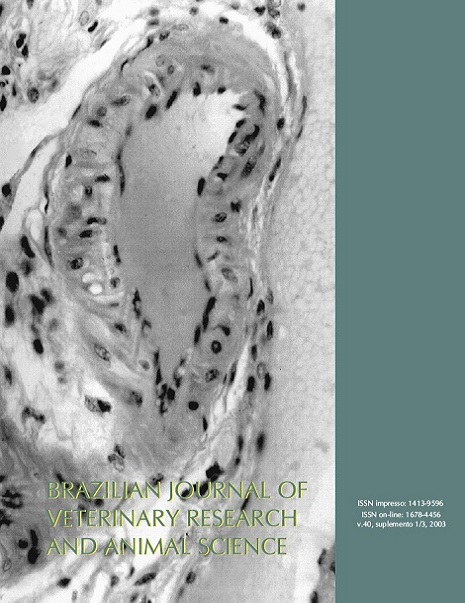Electroneuromyographic evaluation in healthy cats and in those submitted to the nutritional secondary hyperparathyroidism
DOI:
https://doi.org/10.1590/S1413-95962003000700006Keywords:
Cats, Conduction Studies, Electromyography, Hyperparathyroidism, NutritionalAbstract
The aim of this study was to evaluate the motor nerve conduction velocity, neuromuscular transmission, and electromyography at rest in healthy cats (group I) and in cats submitted to the nutritional secondary hyperparathyroidism (group II). Ten mongrel cats, six males and four females, aged between 4 and 5 months and average body weight of 1.67 kg were used to establish normal pattern (group I). Ten mongrel cats, five males and five females, initial age between 2 and 3 months, old and initial body weight of 820 grams were used in group II. After 10 days of adaptation period, the group II animals were fed with raw heart beef for 60 days to induce the nutritional secondary hyperparathyroidism. It was possible to conclude that the motor nerve conduction velocity, and electromyographic findings of insertional and spontaneous activities of cats with nutritional secondary hyperparathyroidism showed similar pattern to healthy cats at the same age. Using repetitive stimulation at 3Hz it was observed global tendency to decrement of the compound muscle action potentials, and using repetitive stimulation at 10Hz a tendency to decrement or increment occurred; though, the variations were at normal limit.Downloads
Download data is not yet available.
Downloads
Published
2003-01-01
Issue
Section
UNDEFINIED
License
The journal content is authorized under the Creative Commons BY-NC-SA license (summary of the license: https://
How to Cite
1.
Rahal SC, Resende LA de L, Mortari AC, Torelli SR, Caporali EHG. Electroneuromyographic evaluation in healthy cats and in those submitted to the nutritional secondary hyperparathyroidism. Braz. J. Vet. Res. Anim. Sci. [Internet]. 2003 Jan. 1 [cited 2026 Jan. 5];40(supl.):38-46. Available from: https://revistas.usp.br/bjvras/article/view/11273





